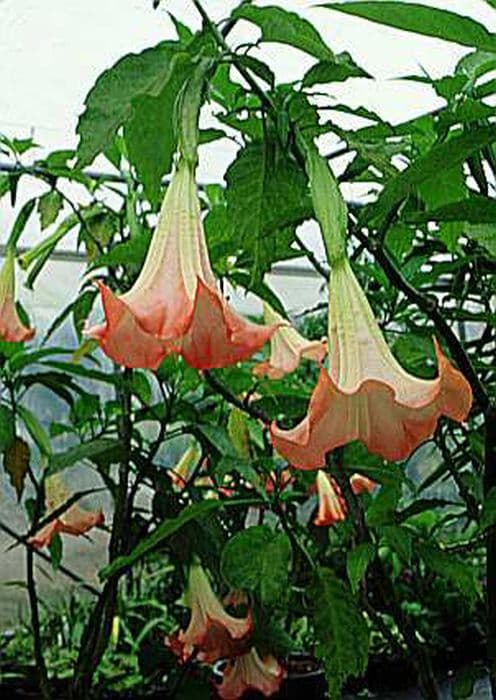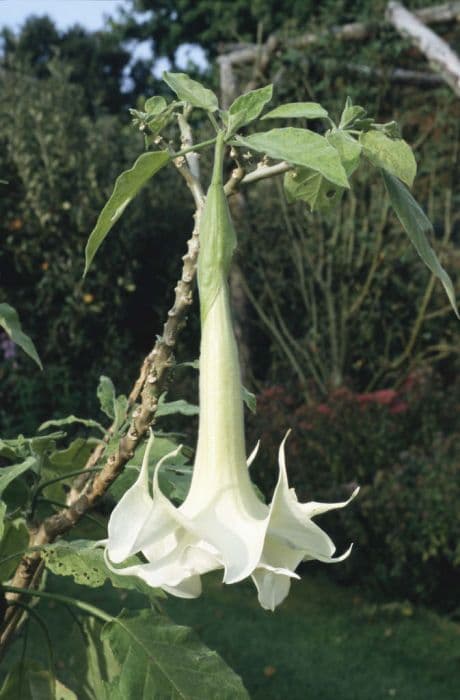Million Bells Calibrachoa Kabloom White = 'Pas1020307' (Kabloom Series)
![calibrachoa [Kabloom White]](/_next/image?url=https%3A%2F%2Fplants-admin.emdemapps.com%2Fimages%2Fplants%2F%2Fimages%2F604b62913d562.png&w=3840&q=75)
ABOUT
The Calibrachoa Kabloom White, part of the Kabloom series, is an ornamental plant characterized by its abundant and showy flowers. The blooms are a pristine white color that creates a striking contrast against the green foliage. These petite flowers resemble miniature petunias, with a funnel-like shape that gracefully opens out into five rounded lobes at the edges. The plant itself is lush, with a plentiful array of green leaves that have a slightly textured appearance. Each leaf is small and ovate with smooth margins, creating a dense backdrop for the mass of white flowers that bloom over the growing season. The Calibrachoa Kabloom White is often admired for its continuous flowering and ability to create a carpet of white that drapes elegantly in its setting. Despite the elimination of size-related details, it can be implied that the plant has a growth habit that lends itself well to container life, hanging baskets, and as an element in mass plantings where its flowers can provide a profusion of color.
About this plant
 Names
NamesFamily
Solanaceae
Synonyms
Mini Petunia, Million Bells
Common names
Calibrachoa Kabloom White = 'Pas1020307' (Kabbloom Series).
 Toxicity
ToxicityTo humans
The plant commonly known as Calibrachoa, including the Kabloom White variety, is not known to be toxic to humans. Generally, ingestion of any part of the plant does not cause severe symptoms of poisoning. However, it is always advisable to avoid eating ornamental plants, as they are not intended for consumption and might cause mild stomach upset or an allergic reaction in sensitive individuals.
To pets
Calibrachoa, which encompasses the Kabloom White variety, is not commonly listed as toxic to pets such as cats and dogs. If a pet ingests this plant, it is unlikely to experience significant symptoms of poisoning. However, ingestion might result in mild gastrointestinal discomfort, including vomiting or diarrhea, particularly if the pet ingests a large quantity. If any concerning symptoms arise after ingestion, contacting a veterinarian is recommended.
 Characteristics
CharacteristicsLife cycle
Annuals
Foliage type
Evergreen
Color of leaves
Green
Flower color
White
Height
6-12 inches (15-30 cm)
Spread
12-24 inches (30-60 cm)
Plant type
Herb
Hardiness zones
9
Native area
South America
Benefits
 General Benefits
General Benefits- Continuous Blooming: The plant produces flowers continuously throughout the growing season without the need for deadheading.
- Low Maintenance: It requires minimal care, making it suitable for busy gardeners or those new to gardening.
- Heat Tolerant: This variety can withstand high temperatures, ensuring it performs well during hot summers.
- Compact Growth: Its compact and mounded growth habit makes it ideal for small spaces and containers.
- Versatile Use: Perfect for hanging baskets, window boxes, and as a colorful groundcover in landscaping.
- Bright White Flowers: Provides a crisp white color that can contrast well with other plants and brighten garden spaces.
- Frost Tolerance: Exhibits a mild level of frost tolerance, which can extend its blooming period in cooler climates.
- Attracts Pollinators: Can help attract bees, butterflies, and other beneficial pollinators to the garden.
- Spreading Habit: It spreads and fills in areas quickly, providing coverage and suppressing weeds.
- Uniformity: The Kabloom series is known for its uniform growth, which results in a tidy and cohesive look in plantings.
 Medical Properties
Medical PropertiesThis plant is not used for medical purposes.
 Air-purifying Qualities
Air-purifying QualitiesThis plant is not specifically known for air purifying qualities.
 Other Uses
Other Uses- Photography and Art Subjects: With their pristine white blooms, Calibrachoa can serve as perfect subjects for photographers and artists looking to capture the delicate beauty of flowers in their work.
- Education and Research: They can be used in educational settings for teaching about hybrid plant development, flower anatomy, and pollination due to their hybrid nature and distinct characteristics.
- Eco-friendly Confetti: Dried petals of Calibrachoa can be used as natural, biodegradable confetti for outdoor celebrations, reducing the environmental impact of traditional plastic confetti.
- Floral Jewelry: Small and sturdy, the flowers of Calibrachoa can be used to create unique, live floral jewelry such as earrings or pendants for special occasions.
- Culinary Decoration: Although not edible, the flowers can be used as a non-toxic decorative element on cakes and dishes for events, instantly enhancing their visual appeal.
- Miniature Gardens: Due to their compact growth, Calibrachoa are suitable for creating fairy or miniature gardens, offering a whimsical element to small-scale landscapes.
- Bath Bombs and Soaps: Calibrachoa petals can be incorporated into homemade bath bombs and soaps for added visual appeal, although they should be used for their appearance rather than any skincare benefits.
- Crafting and Scrapbooking: Pressed Calibrachoa flowers can be used in crafting projects or scrapbooking, adding a touch of nature to creative works.
- Color Inspiration: The pure white of 'Kabloom White' Calibrachoa can provide color inspiration for interior designers, fashion designers, and artists seeking a fresh, clean palette.
- Ikebana: 'Kabloom White' can be used in the Japanese art of flower arrangement, Ikebana, where its simplicity and elegance could reflect purity and tranquility within a composition.
Interesting Facts
 Feng Shui
Feng ShuiThe Million Bells is not used in Feng Shui practice.
 Zodiac Sign Compitability
Zodiac Sign CompitabilityThe Million Bells is not used in astrology practice.
 Plant Symbolism
Plant Symbolism- Purity: The white blossoms of the Calibrachoa are often associated with purity and innocence due to their clean and crisp color.
- Healing: The soothing color and gentle appearance of the Calibrachoa can symbolize healing and peace, providing comfort to those in need.
- Simplicity: The Calibrachoa's straightforward beauty often signifies simplicity and an appreciation for the less complicated aspects of life.
- New Beginnings: Flowers in general, and white flowers like the Calibrachoa, can represent new beginnings, reflecting hope and the start of something fresh.
 Water
WaterMillion Bells should be watered regularly, allowing the top inch of soil to dry out between waterings. Deep and thorough watering is recommended for these plants, rather than a light sprinkle. Aim to water these plants about every other day during hot weather, decreasing to once a week during cooler periods. On average, during peak summer conditions, the plant may use about 1-2 gallons per week, depending on the size of the plant and environmental conditions. Overwatering or allowing the plant to sit in water can lead to root rot, so ensure proper drainage.
 Light
LightMillion Bells thrives in full sun, requiring at least 6 hours of direct sunlight each day to flourish and produce abundant blooms. The best spot for these plants is an area that receives morning sun and some protection from the intense, scorching sun of the late afternoon if possible. However, these plants can also handle full exposure throughout the day if acclimated properly.
 Temperature
TemperatureMillion Bells prefers moderate temperatures and can tolerate a range from about 40°F to 90°F. They perform best in temperatures between 60°F and 75°F, which encourages optimal growth and flowering. Extreme heat or frost can damage the plant, so it is crucial to protect them from temperatures below 40°F and above 90°F by providing shade or frost covers as necessary.
 Pruning
PruningPruning Million Bells encourages a fuller plant with more blooms and helps prevent legginess. Prune or pinch back the tips of the plant every few weeks to promote branching. The best time for major pruning is in midsummer when the plant may start to look worn. By cutting the stems back by up to half, it will rejuvenate and continue to bloom into the fall.
 Cleaning
CleaningAs needed
 Soil
SoilCalibrachoa, commonly known as Million Bells, thrives in a well-draining potting mix with a soil pH between 5.5 and 6.0. A good mix would be equal parts peat, perlite, and potting soil to ensure proper drainage and aeration. Fertilization should be regular, as Calibrachoa are heavy feeders.
 Repotting
RepottingMillion Bells should be repotted annually, as they tend to grow vigorously and can quickly become root-bound. Repotting should be done in the spring before the onset of the growing season to allow the plant to establish in its new container.
 Humidity & Misting
Humidity & MistingMillion Bells prefers moderate humidity levels. While they can tolerate some variation, it is crucial to ensure that the humidity does not become too high, as this could encourage fungal diseases. An ambient humidity level of 40-50% is ideal for these plants.
 Suitable locations
Suitable locationsIndoor
Ensure bright light, regular feeding, and good air flow for Million Bells.
Outdoor
Place in full sun, ensure good drainage, feed regularly, deadhead spent blooms.
Hardiness zone
9-11 USDA
 Life cycle
Life cycleThe life cycle of Calibrachoa 'Kabloom White' begins with seed germination, which occurs in warm, moist soil conditions. After germination, the seedling emerges and starts to develop its first true leaves and root system. During the vegetative stage, the plant experiences rapid growth, producing a bushy foliage and preparing for flowering. The flowering stage is marked by the blooming of white, petunia-like flowers that attract pollinators and can occur multiple times throughout the growing season when conditions are favorable. Following pollination, the plant may produce small, non-viable seeds, as many Calibrachoa cultivars are sterile. The life cycle completes with senescence, where the plant's growth slows, leaves may yellow, and it eventually dies back, usually at the onset of cooler temperatures or with a decline in growing conditions.
 Propogation
PropogationPropogation time
Spring to Summer
The most popular method of propagation for Calibrachoa, commonly known as Million Bells, particularly the Kabloom White series, is through seed sowing. Since Calibrachoa Kabloom White ‘Pas1020307’ is a hybrid, it is specifically bred to be propagated by seeds, which is a common commercial method for producing large numbers of plants. Seeds are typically sown in late winter to early spring, around 8 to 10 weeks before the last frost date. They require light for germination, so they should be pressed into the surface of a well-drained seed starting mix and not covered. The trays should be kept at a consistent temperature of around 70 to 75 degrees Fahrenheit (21 to 24 degrees Celsius), and the seedlings usually emerge in 7 to 14 days. Once the seedlings have developed several true leaves and are large enough to handle, they can be transplanted into individual pots or hanging baskets.


![Calibrachoa [Aloha Classic Blue Sky]](/_next/image?url=https%3A%2F%2Fplants-admin.emdemapps.com%2Fimages%2Fplants%2F%2Fimages%2F604b636c3778b.png&w=640&q=75)
![Calibrachoa [Aloha Classic Gold]](/_next/image?url=https%3A%2F%2Fplants-admin.emdemapps.com%2Fimages%2Fplants%2F%2Fimages%2F604b6284c573e.png&w=640&q=75)
![Calibrachoa [Aloha Classic Tiki Soft Pink]](/_next/image?url=https%3A%2F%2Fplants-admin.emdemapps.com%2Fimages%2Fplants%2F%2Fimages%2F604b548e0a5ef.png&w=640&q=75)
![Calibrachoa [Cabaret Deep Yellow]](/_next/image?url=https%3A%2F%2Fplants-admin.emdemapps.com%2Fimages%2Fplants%2F%2Fimages%2F604b5f20ca3ef.png&w=640&q=75)
![Calibrachoa [Calibasket Radiant Orange]](/_next/image?url=https%3A%2F%2Fplants-admin.emdemapps.com%2Fimages%2Fplants%2F%2Fimages%2F604b536d43cb2.png&w=640&q=75)
![Calibrachoa [Caloha Classic Blue Velvet]](/_next/image?url=https%3A%2F%2Fplants-admin.emdemapps.com%2Fimages%2Fplants%2F%2Fimages%2F604b604884a75.png&w=640&q=75)
![Calibrachoa [Caloha Classic Honey White]](/_next/image?url=https%3A%2F%2Fplants-admin.emdemapps.com%2Fimages%2Fplants%2F%2Fimages%2F604b5f56e0beb.png&w=640&q=75)
![Calibrachoa [Caloha Classic Yellow Chocolate Ring]](/_next/image?url=https%3A%2F%2Fplants-admin.emdemapps.com%2Fimages%2Fplants%2F%2Fimages%2F604b538aede95.png&w=640&q=75)